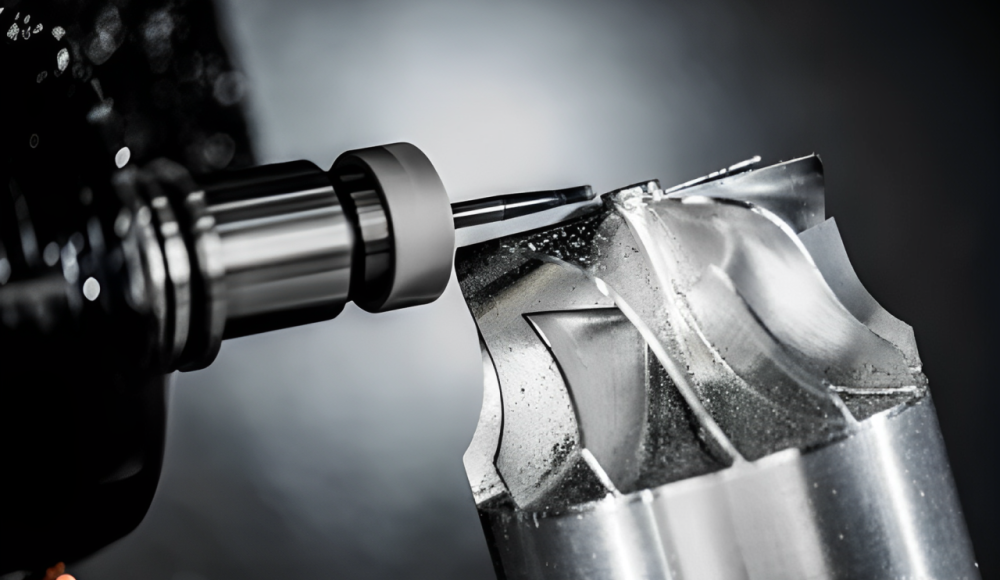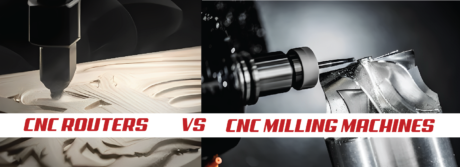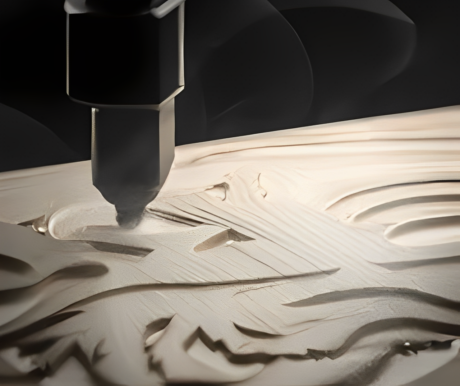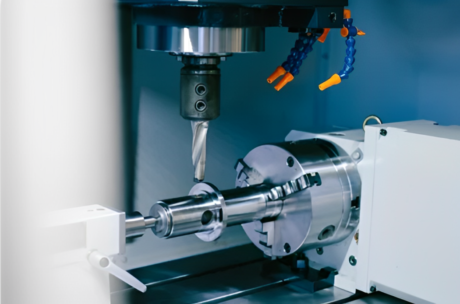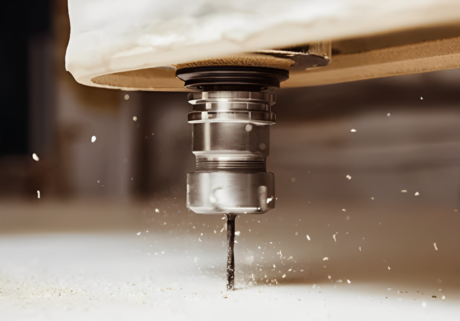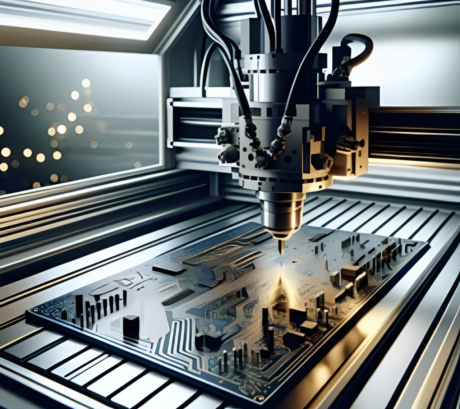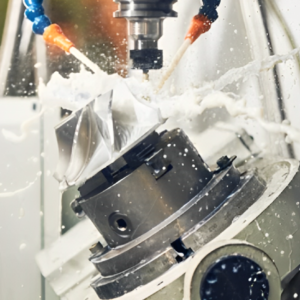CNC (Controle Numérico Computadorizado) máquinas ajudam os processos de fabricação a fornecer, preciso, e resultados eficientes. As máquinas de fabricação de CNC comuns incluem o Máquinas de moagem CNC e o Roteadores CNC. Ambas as máquinas dependem do controle do computador para cortar formas ou gravar algum material. Mas, Eles são mais apropriados para diferentes propósitos, principalmente por causa de seu design. Então, Este artigo lidará com uma comparação detalhada entre as máquinas de moagem CNC e os roteadores CNC.
O que é uma máquina de moagem CNC?
O moinho de CNC é uma máquina versátil que pode ser usada para cortar vários materiais. Esses materiais são principalmente metais em formas e tamanhos geométricos variados através de uma ferramenta de cortador rotativa. além disso, É a melhor opção para energia e precisão. Por exemplo, Ajuda as peças de metal da máquina, ou seja. aviões suaves e complexos. Alguns dos tipos comuns de máquinas de moagem são máquinas de moagem montadas em bancada e grandes máquinas de moagem industrial. Array e geralmente, menos flexível que roteadores CNC. Eles trabalham em maiores precisões em comparação com os roteadores CNC. Então, Isso os torna adequados para tarefas exigentes altamente coreografadas com um acabamento de alta qualidade de superfície.
O que significa roteador CNC?
Roteador CNC - uma ferramenta que corta os materiais mais macios, como a madeira, PVC, e espuma. Emprega um eixo redondo que oscila tanto na vertical quanto na horizontal. Então, pode cortar, forma, ou inscreva -se no material em uso. Comparado às máquinas de moagem, Os roteadores CNC são geralmente mais versáteis e têm uma velocidade mais alta do eixo. Particularmente quando usado com materiais de estoque mais leves e, portanto, amplamente utilizados nas indústrias de madeira, bem como na produção de sinalizações, móveis, entre outros. No entanto, Eles também podem fazer alguns trabalhos de corte de metal menores, como o uso de chapa metal enquanto não são recomendados para trabalhos de heavy metal.
Como funciona uma máquina de moagem CNC?
Máquinas de moagem CNC Empregue cortadores rotativos para cortar o material na forma e tamanho desejados através de instruções de um código de computador conhecido como código G. A maioria das máquinas trabalha em vários eixos com o número geralmente variando entre 3 e 5 eixos para permitir a ferramenta de componentes de alta precisão e geometria. A peça de trabalho, por outro lado, permanece estática ou apenas traduz ao longo do x, S, e z instrumentos enquanto o cortador de moagem está em rotação em alta velocidade.
Como funciona um roteador CNC?
Como as máquinas de moagem CNC, Os roteadores CNC usam uma ferramenta de corte de controle numérico de computador. Embora sejam diferentes, são ideais para corte de alta velocidade em uma área de trabalho maior. Envolve o uso de uma ferramenta de corte que desliza na superfície do material pelo roteador através de diferentes eixos. Então, Pode ajudar a alcançar a forma ou design necessário. Sabe -se que os roteadores CNC têm uma RPM mais alta do que as máquinas de moagem CNC, o que o torna ideal para uso com materiais mais suaves. Além disso, sua operação não é tão precisa quanto outras máquinas, mas é mais flexível e mais rápida. Então, Eles são adequados para projetos arquitetônicos e outros delicados em produtos não metálicos.
Materiais para máquinas de moagem CNC
Os roteadores CNC são versáteis para cortar os seguintes materiais:
- Placas únicas de madeiras temperadas, faia, e bétula mista ou mista de bétula acabada, olmo, e Walnut.
- Plásticos (acrílico, PVC, abdômen)
- Espuma (para prototipagem)
- Compósitos (fibra de vidro, fibra de carbono)
- Alumínio (Lençóis finos- Uso leve)
Materiais para roteamento CNC
As máquinas de moagem CNC são mais robustas e capazes de lidar com os seguintes materiais:
- Aço
- O alumínio geralmente tem uma forma transversal mais espessa e mais complexa é usada.
- Latão
- Titânio
- Plásticos (para usinagem de precisão)
A diferença entre uma máquina de moagem CNC e um roteador CNC
Então, Vamos fazer uma comparação entre as máquinas de moagem CNC e os roteadores CNC.
1. Capacidade de material
As máquinas de moagem CNC são projetadas para cortar materiais mais difíceis, ou seja. metal (aço, Ferro, alumínio, titânio). Então, É por isso que eles são adequados para indústrias rigorosas, como as indústrias aeroespacial e de automóveis. Os roteadores CNC são empregados principalmente para cortar materiais mais claros, ou seja. madeira, plásticos, e espumas, e as máquinas não são construídas para cortar metal grosso ou duro.
2. Precisão
As máquinas de moagem CNC são rígidas por causa de seus projetos. Então, ajuda a produzir componentes com alta precisão. Especialmente, Quando as tolerâncias são apertadas e os projetos complicados são necessários, As máquinas de moagem CNC são mais adequadas. Por outro lado, Os roteadores CNC são precisos no corte de outros materiais mais suaves, mas menos precisos na maioria dos casos. Enquanto são rápidos, eles não são tão finos quanto podem ser.
3. Velocidade de corte
As máquinas de moagem CNC funcionam a uma velocidade mais lenta, Quando em contato com materiais difíceis. Então, Eles podem evitar afiadores, já que o corte está envolvido. Os roteadores CNC são projetados especificamente para funcionar com velocidade. Então, Isso facilita o corte e o desempenho efetivamente os processos de usinagem em materiais mais suaves dos processos de produção.
4. Movimento do eixo
Máquinas de moagem CNC funcionam usando vários eixos no máximo cinco eixos. Eles são utilizados na produção de produtos complexos e de várias camadas. além disso, Os roteadores CNC só podem se mover 3 eixos e são usados em maior, superfícies mais simples. Além disso, sua construção não prioriza as contorções complexas de uma ferramenta.
5. Custo
As máquinas de moagem CNC, no entanto, são um pouco mais caras do que as máquinas de moagem comuns. É principalmente por causa da melhor precisão, poder, e capacidade de lidar com RAW, materiais duros. Eles começam de $10000 para um valor sobre $100000. Por outro lado, Os roteadores CNC são um pouco mais baratos, com preços que variam de $5,000 com suas aplicações sendo mais inclinadas a materiais mais suaves e operações menos complexas.
Então, A tabela a seguir fornecerá informações profundas sobre a comparação entre as máquinas de moagem CNC e os roteadores CNC.
| Aspecto | Máquina de moagem CNC | Roteador CNC |
| Capacidade de material | Metais (por exemplo., aço, alumínio, latão, titânio) | Materiais mais suaves (por exemplo., madeira, plástico, espuma, alumínio fino) |
| Precisão | Alta precisão (± 0.01 milímetros) | Precisão moderada (± 0.1 milímetros) |
| Velocidade de corte | Mais devagar (RPM: 1,000 – 10,000) | Mais rápido (RPM: 10,000 – 24,000) |
| Movimento do eixo | 3 para 5 eixos (para geometrias complexas) | Tipicamente 3 eixos (X, S, Z) |
| Custo | $10,000 – $100,000+ | $5,000 – $50,000 |
| Força | Alto (construído para difícil, trabalho de grau industrial) | Moderado (focado em materiais mais suaves e velocidade mais alta) |
| Eficiência de velocidade | Baixa velocidade, focado em precisão | De alta velocidade, focado na produção |
| Formulários | Aeroespacial, automotivo, peças industriais | Carpintaria, sinalização, mobília, Corte de espuma |
| Tolerância típica | ± 0.01 milímetros | ± 0.1 milímetros |
| Poder do fuso | Mais alto (5-30 HP) | Mais baixo (2-5 HP) |
| Peso | 1,000 – 5,000 kg (mais pesado e mais robusto) | 200 – 1,000 kg (isqueiro) |
| Tamanho da peça | Peças de trabalho menores (mas mais complexo) | Peças de trabalho maiores (com geometria mais simples) |
| Ambiente operacional | Requer configuração e espaço industrial | Pode ser usado em oficinas menores |
Quando selecionar uma máquina de moagem CNC?
Então, A seguir, são diferentes aspectos em que você deve escolher máquinas de moagem CNC:
- Sempre que é necessário ser preciso e fornecer grandes detalhes.
- Ao trabalhar em aço, alumínio e titânio, por exemplo.
- Especificamente na produção de componentes industriais de precisão.
- Sempre que é necessário para um material mais resistente e espesso, uma máquina industrial pode ser usada.
- Quando certas tarefas mais exigentes devem ser executadas, o apego robusto é chamado em jogo.
Quando selecionar um roteador CNC?
Aqui estão algumas ocasiões em que os roteadores CNC são uma das melhores opções para ir:
- Por exemplo, em projetos em que a linha de montagem precisa manter a taxa de produção.
- Lida com materiais mais suaves.
- Para grandes peças planas, como sinais de publicidade e móveis, como mesas, cadeiras, entre outras.
- Quando o design é elaborado e complexo e a necessidade de flexibilidade na produção também é vital.
- O torno de três fases de Kyandee foi projetado para pequenos trabalhos de metal e cortes de espuma ou plástico e fabricação de protótipos.
Qual é a diferença de custo entre uma máquina de moagem CNC e um roteador CNC?
A maioria das máquinas de moagem CNC são caras por causa de sua precisão, vida mais longa, e capacidade de trabalhar com materiais mais difíceis. Eles podem se espalhar em qualquer lugar entre $10,000 e $150,000 ou mais e mais dependendo da marca, tamanho, e opções. Os roteadores CNC, por outro lado, são comparativamente mais baratos, custo variando de $5000 para o modelo básico e $30000 Para o modelo sofisticado. Isso é esperado devido às diferenças no tipo de material em que os dois tipos de máquinas pretendem trabalhar, bem como as respectivas taxas de precisão que elas são programadas para entregar.
O que é melhor: uma máquina de moagem CNC ou um roteador CNC:
A decisão entre uma máquina de moagem CNC e um roteador CNC depende em grande parte de suas necessidades específicas:
- Máquinas de moagem CNC: Eles são perfeitos para precisão, trabalho de qualidade, e ao trabalhar com materiais como metais e são usados para trabalhos pesados.
- Roteadores CNC:Eles são mais apropriados para corte de design alto e flexível e bons para materiais, ou seja. madeira ou plástico.
Vantagens das máquinas de moagem CNC e algumas desvantagens
A seguir, são apresentadas algumas vantagens e desvantagens das máquinas de moagem CNC:
Prós:
- Alta precisão e exatidão.
- O corte também pode ser feito em formas mais difíceis de metais.
- Especialmente aplicável quando há trabalho de manipulação frequente e preciso.
- Alta rigidez e durabilidade.
- A tecnologia é capaz de acomodar geometrias de alta complexidade.
Contras:
- Custo mais alto.
- Mais lento que roteadores CNC.
- Requer mais manutenção.
- Pegada maior.
- As encostas são mais íngremes para operadores de equipamentos com estrias de rovo do que para operadores de equipamentos sem esteiras.
Vantagens e desvantagens dos roteadores CNC
Aqui estão alguns méritos e deméritos dos roteadores CNC:
Prós:
- Velocidade de corte mais rápida.
- É barato em comparação com outras máquinas, como máquinas de moagem.
- Perfeito para materiais mais suaves e modelos, como madeira, e plásticos, entre outros.
- Versátil e amigável, especialmente ao trabalhar em projetos relacionados à arte.
- Pegada menor.
Contras:
- Ao contrário das máquinas de moagem, Eles não são muito precisos.
- Não é bom para processamento de metal em larga escala.
- Menor rigidez e força.
- Variedade de material limitado.
Aplicações de máquinas de moagem CNC
Estas são algumas áreas de aplicações de máquina de moagem CNC:
- Criando peças de metais precisas e finas.
- Ferramenta e matriz.
- Conjuntos aeroespaciais e automotivos.
- Componentes de dispositivos médicos.
- Complexo, usinagem de alta tolerância.
Aplicações de roteadores CNC
Aqui estão alguns usos dos roteadores CNC:
- Fabricação de móveis.
- Sinalização e escultura 3D.
- Trabalho artístico e decorativo.
- Criação e fabricação de peças de espuma e plásticos dos primeiros exemplos.
- Trabalho de alumínio leve.
Conclusão
Para ir para uma máquina de moagem CNC ou um roteador CNC depende do tipo e tipo de material para trabalhar, e o nível de precisão necessário. além disso, Também é importante ter a quantidade de dinheiro que você está disposto a gastar. As máquinas de moagem CNC oferecem maior precisão e durabilidade do que seus colegas devido ao seu uso em aplicações de metal e industrial. Por outro lado, Os roteadores CNC são comparativamente mais rápidos e são mais versáteis para operações de materiais mole, como trabalhos de madeira e sinais. Recomenda -se avaliar seus requisitos para fabricação, o que ajudará a concluir qual das duas máquinas é mais adequada para a atividade da empresa.
perguntas frequentes
1º trimestre. Um roteador CNC pode cortar metal?
Sim, pode. Mas os roteadores CNC são adequados para metais mais macios do que metais muito mais difíceis, ou seja. aço.
2º trimestre. Quais materiais uma alça de máquina de moagem CNC pode?
Aço, alumínio, titânio, e o plástico também pode ser trabalhado usando máquinas de moagem CNC.
3º trimestre. Qual é o preço de uma máquina de moagem CNC?
Se estamos falando de uma máquina de moagem CNC, então ele variará de $10,000 para superar $100,000. No entanto, O tamanho e as funções do equipamento variam.

